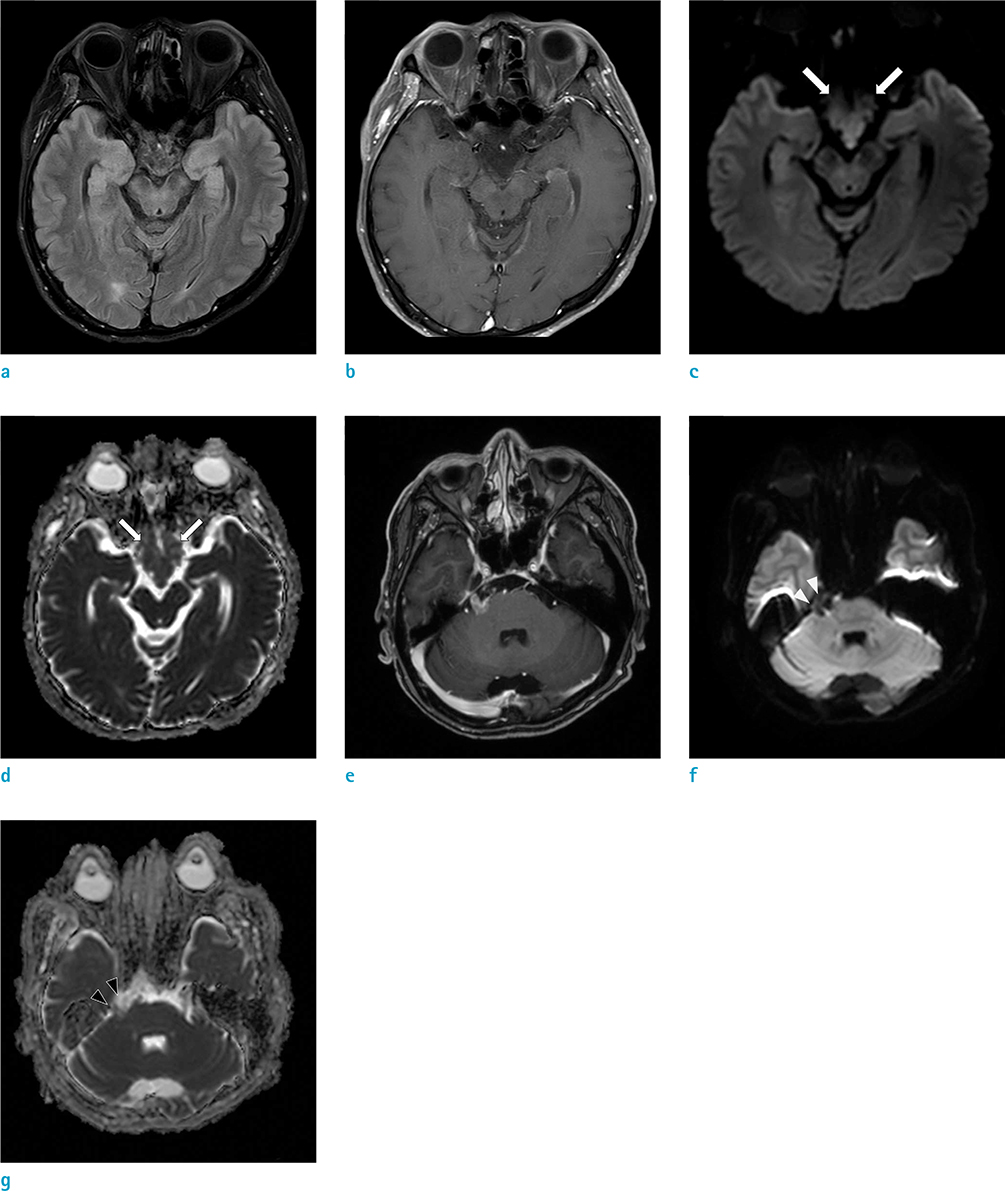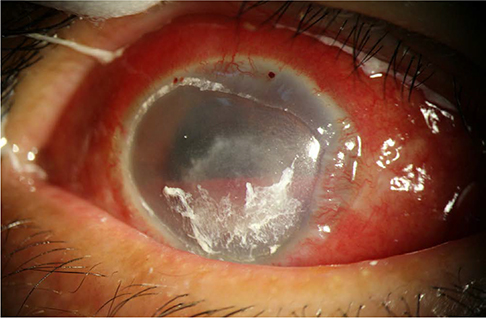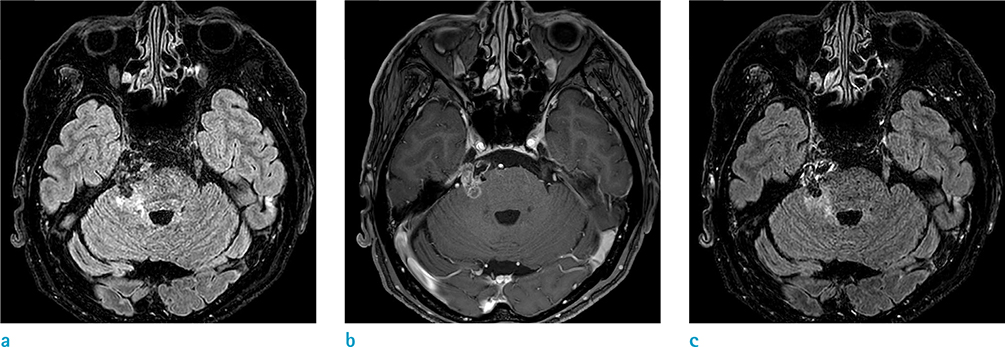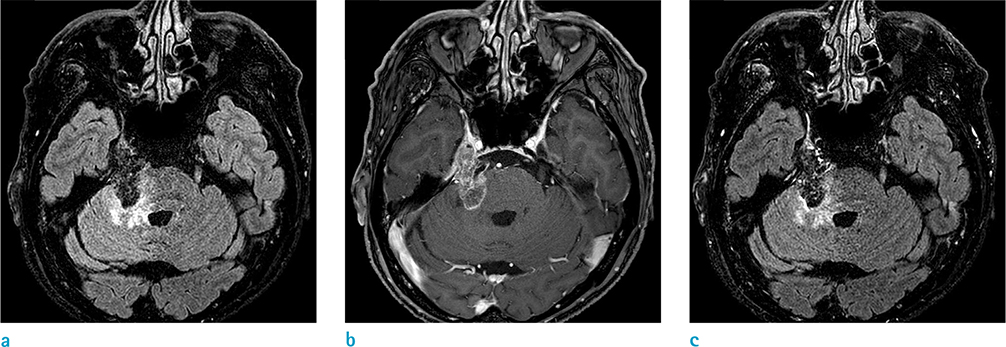Investig Magn Reson Imaging.
2018 Sep;22(3):172-176. 10.13104/imri.2018.22.3.172.
Coexistence of Intracranial Squamous Cell Carcinoma and Epidermoid Cyst: a Case with Consecutive Imaging Findings
- Affiliations
-
- 1Department of Radiology and Research Institute of Radiology, University of Ulsan College of Medicine, Seoul, Korea. jieunp@gmail.com
- KMID: 2421549
- DOI: http://doi.org/10.13104/imri.2018.22.3.172
Abstract
- In contrast to well-known imaging findings of intracranial epidermoid cysts on magnetic resonance imaging, those of intracranial squamous cell carcinoma (SqCC) are relatively unknown. We present a case of coexistence of intracranial SqCC and epidermoid cyst, with consecutive follow up over 14 months. Based on our case, a solid enhancing portion adjacent to a typically-looking epidermoid cyst may become a clue for coexistence of intracranial SqCC. An initial contrast enhancement and/or heterogeneous signal on diffusion weighted imaging may become a useful diagnostic clue, but more importantly, sudden rapid growth is important in formulating diagnosis.
MeSH Terms
Figure
Reference
-
1. Ahmed I, Auguste KI, Vachhrajani S, Dirks PB, Drake JM, Rutka JT. Neurosurgical management of intracranial epidermoid tumors in children. Clinical article. J Neurosurg Pediatr. 2009; 4:91–96.2. Roh TH, Park YS, Park YG, Kim SH, Chang JH. Intracranial squamous cell carcinoma arising in a cerebellopontine angle epidermoid cyst: a case report and literature review. Medicine (Baltimore). 2017; 96:e9423.3. Wagle WA, Jaufmann B, Mincy JE. Magnetic resonance imaging of fourth ventricular epidermoid tumors. Arch Neurol. 1991; 48:438–440.
Article4. Kim MS, Kim OL. Primary intracranial squamous cell carcinoma in the brain stem with a cerebellopontine angle epidermoid cyst. J Korean Neurosurg Soc. 2008; 44:401–404.
Article5. Hamlat A, Hua ZF, Saikali S, et al. Malignant transformation of intra-cranial epithelial cysts: systematic article review. J Neurooncol. 2005; 74:187–194.
Article6. Uchino A, Hasuo K, Matsumoto S, et al. Intracranial epidermoid carcinoma: CT and MRI. Neuroradiology. 1995; 37:155–158.
Article7. Abramson RC, Morawetz RB, Schlitt M. Multiple complications from an intracranial epidermoid cyst: case report and literature review. Neurosurgery. 1989; 24:574–578.
Article8. Nakao Y, Nonaka S, Yamamoto T, et al. Malignant transformation 20 years after partial removal of intracranial epidermoid cyst--case report. Neurol Med Chir (Tokyo). 2010; 50:236–239.9. Ozutemiz C, Ada E, Ersen A, Ozer E. Imaging findings of an epidermoid cyst with malignant transformation to squamous cell carcinoma. Turk Neurosurg. 2017; 27:312–315.
Article10. Nawashiro H, Higo R, Tokumaru AM, Tsuzuki N, Shima K. Diffusion-weighted MRI of an intracranial epidermoid with malignant transformation. Neuroradiology. 2001; 43:891.
Article
- Full Text Links
- Actions
-
Cited
- CITED
-
- Close
- Share
- Similar articles
-
- Primary Intracranial Epidermoid Carcinoma
- Primary Intracranial Squamous Cell Carcinoma in the Brain Stem with a Cerebellopontine Angle Epidermoid Cyst
- Malignant Transformation of an Epidermoid Cyst in the Cerebellopontine Angle
- Squamous cell carcinoma arising from a long-standing epidermoid cyst of the back
- Epidermoid Cyst after Groin Flap Mimicking Malignancy





